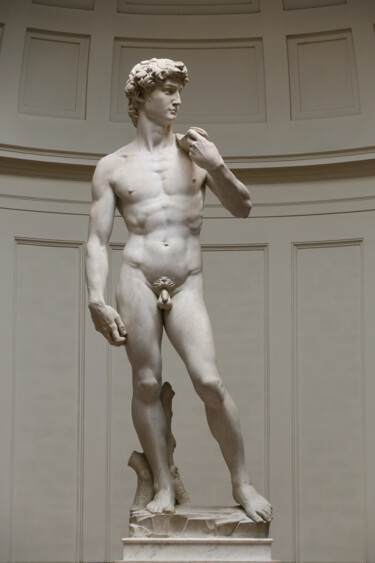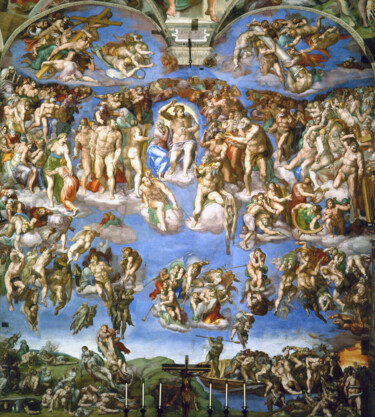Michelangelo
Michelangelo di Lodovico Buonarroti Simoni, commonly known as Michelangelo, was born on March 6, 1475, in Caprese, Italy, and is widely regarded as one of the greatest artists in the history of Western art. A painter, sculptor, architect, and poet, Michelangelo's work embodied the Renaissance ideals of humanism, showcasing a mastery of both technique and emotion. His legacy is defined by his ability to transform both marble and fresco into works of profound expression and technical virtuosity.
Michelangelo's early education began in Florence, where he trained as a sculptor under the guidance of renowned artists. At the age of 16, he was taken under the patronage of Lorenzo de' Medici, a key figure in the Florentine Renaissance, where he honed his skills and came into contact with other celebrated artists of the time. In 1496, he moved to Rome, where his monumental career began with the creation of Pietà, a marble sculpture that displays a striking level of detail and emotional depth.
Michelangelo's most famous works include the David, a towering marble statue that has come to symbolize human strength and beauty, and his frescoes on the ceiling of the Sistine Chapel in the Vatican, completed between 1508 and 1512. The Sistine Chapel ceiling is a triumph of artistic imagination, featuring scenes from the Book of Genesis, including the iconic Creation of Adam. His use of perspective, anatomical precision, and dramatic compositions redefined the possibilities of painting and cemented his reputation as a master of the medium.
In addition to his achievements in sculpture and painting, Michelangelo was also an accomplished architect. He played a pivotal role in the design of St. Peter's Basilica in Vatican City, where he served as chief architect in the later years of his life, creating the basilica’s iconic dome.
Michelangelo’s art was deeply influenced by his personal struggles, religious faith, and a constant drive for perfection. His works are known for their intense emotion, idealized human forms, and a sense of divine presence. He lived and worked through the political and artistic upheavals of Renaissance Italy, often at odds with patrons and fellow artists alike.
Michelangelo died on February 18, 1564, in Rome at the age of 88. His influence on art, architecture, and culture continues to be profound, with his works inspiring generations of artists and cementing his place as a key figure in the history of Western art.
Discover contemporary artworks by Michelangelo, browse recent artworks and buy online. Categories: contemporary italian artists. Artistic domains: Painting, Sculpture. Artist represented by ArtMajeur by YourArt Editions. Account type: Artist , member since 2022 (Country of origin Italy). Buy Michelangelo's latest works on ArtMajeur: Discover great art by contemporary artist Michelangelo. Browse artworks, buy original art or high end prints.

Artist Value, Biography, Artist's studio:
Dernières Œuvres • 5 artworks
View allRecognition
Artist recognized for their exceptional expertise and their influence on the art world
The Artist was highlighted in an article in ArtMajeur Magazine
Biography
Michelangelo di Lodovico Buonarroti Simoni, commonly known as Michelangelo, was born on March 6, 1475, in Caprese, Italy, and is widely regarded as one of the greatest artists in the history of Western art. A painter, sculptor, architect, and poet, Michelangelo's work embodied the Renaissance ideals of humanism, showcasing a mastery of both technique and emotion. His legacy is defined by his ability to transform both marble and fresco into works of profound expression and technical virtuosity.
Michelangelo's early education began in Florence, where he trained as a sculptor under the guidance of renowned artists. At the age of 16, he was taken under the patronage of Lorenzo de' Medici, a key figure in the Florentine Renaissance, where he honed his skills and came into contact with other celebrated artists of the time. In 1496, he moved to Rome, where his monumental career began with the creation of Pietà, a marble sculpture that displays a striking level of detail and emotional depth.
Michelangelo's most famous works include the David, a towering marble statue that has come to symbolize human strength and beauty, and his frescoes on the ceiling of the Sistine Chapel in the Vatican, completed between 1508 and 1512. The Sistine Chapel ceiling is a triumph of artistic imagination, featuring scenes from the Book of Genesis, including the iconic Creation of Adam. His use of perspective, anatomical precision, and dramatic compositions redefined the possibilities of painting and cemented his reputation as a master of the medium.
In addition to his achievements in sculpture and painting, Michelangelo was also an accomplished architect. He played a pivotal role in the design of St. Peter's Basilica in Vatican City, where he served as chief architect in the later years of his life, creating the basilica’s iconic dome.
Michelangelo’s art was deeply influenced by his personal struggles, religious faith, and a constant drive for perfection. His works are known for their intense emotion, idealized human forms, and a sense of divine presence. He lived and worked through the political and artistic upheavals of Renaissance Italy, often at odds with patrons and fellow artists alike.
Michelangelo died on February 18, 1564, in Rome at the age of 88. His influence on art, architecture, and culture continues to be profound, with his works inspiring generations of artists and cementing his place as a key figure in the history of Western art.
-
Nationality:
ITALY

- Date of birth : unknown date
- Artistic domains: Represented by a Gallery,
- Groups: Contemporary Italian Artists Artists presented by a gallery






